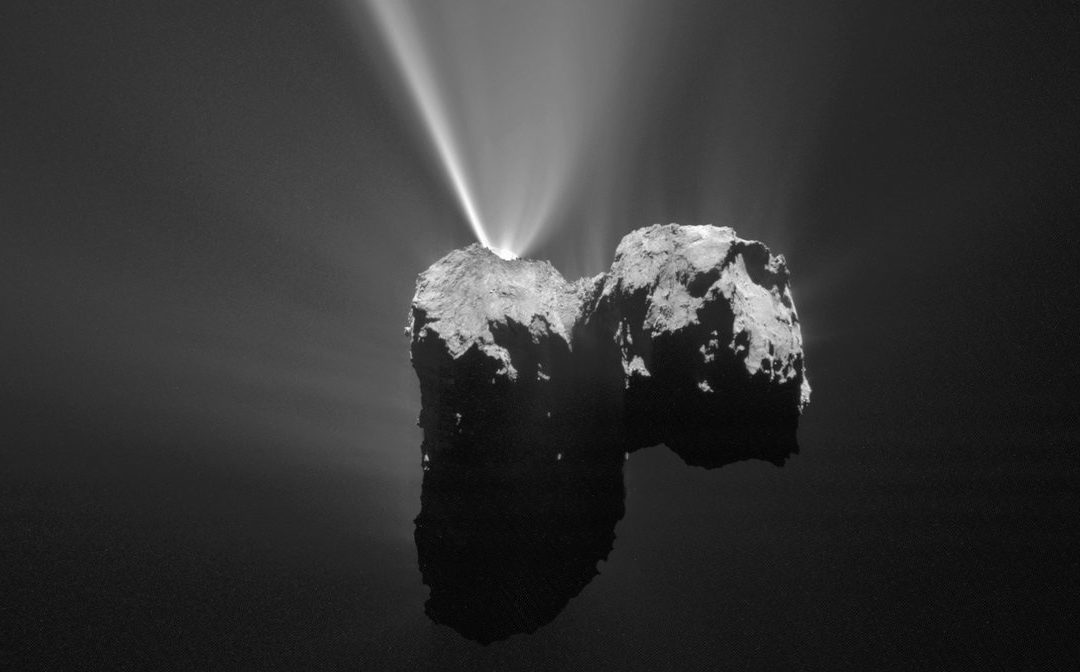Some of the smallest members of our solar system have been known since antiquity. Comets were very mysterious objects to the ancient world. They had an unusual “hairy” appearance.[1] Unlike planets, comets seemed to follow no predictable path. They appeared at an unpredictable time, brightened and moved in unpredictable ways, and faded into oblivion. Many cultures considered comets to be omens.
Curiously, comets were originally considered to be an atmospheric phenomenon. This belief persisted until the appearance of the Great Comet of 1577. Tycho carefully recorded the position of this comet at various times. He found by parallax that the comet was therefore far more distant than the moon. For the first time, astronomers realized that comets were truly celestial, rather than meteorological.
Anatomy of a Comet
Advances in technology have allowed astronomers to learn a great deal about comets. Modern telescopes enable astronomers to discover and monitor comets long before (and after) they are visible to the unaided eye. Nine comets have been visited by manmade spacecraft, and we have learned much about their composition and properties.
A comet is a mass of ice and dirt that orbits the sun. They appear as a fuzzy “cloud” in the night sky, often with a tail or tails which point away from the sun. Whereas planets have low eccentricity (and hence a fairly circular orbit), comets generally have a very high eccentricity. As such, they spend most of their time in the outer solar system, far from the warmth of the sun. At such distances, their icy material remains frozen. However, when a comet swings through the inner solar system, solar energy vaporizes some of the icy material, which forms a cloud called a coma. Furthermore, solar wind and radiation stream away from the sun and press on the material ejected from the comet’s central nucleus. This is what causes the comet to have a tail that points away from the sun.
The nucleus of a comet – its central mass – is typically one to six miles in diameter.[2] When the Giotto spacecraft visited Halley’s comet in 1986, it obtained spectacular images of the nucleus, including spots of outgassing of the volatile material. Such material consists of ices, especially water-ice, along with frozen forms of ammonia, methane, and carbon dioxide. The dirt component consists mainly of silicates and some metals.
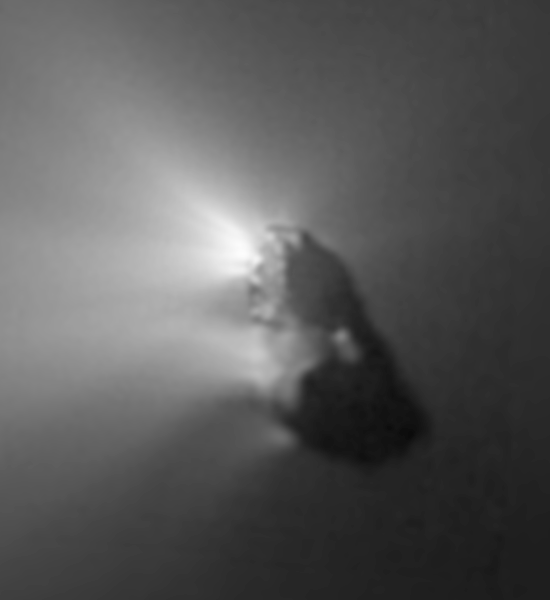
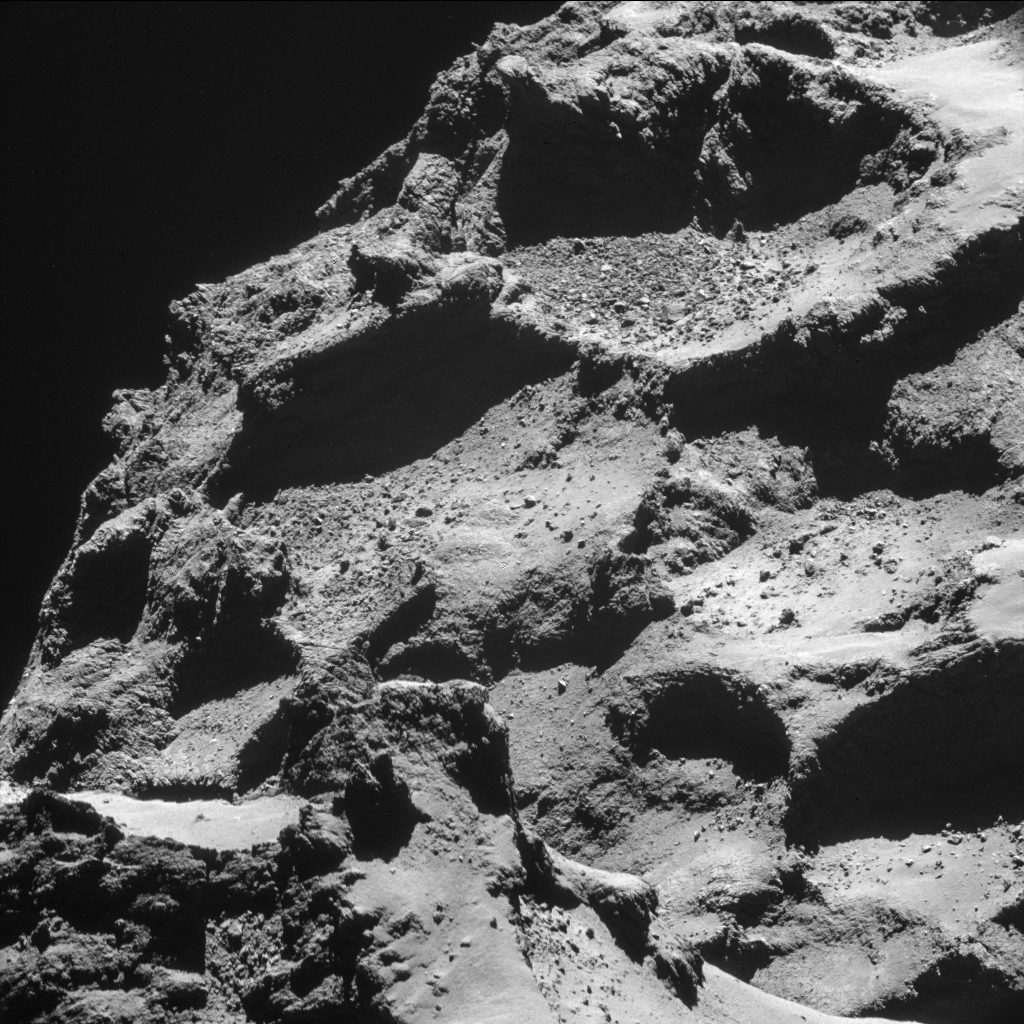
The small size of a comet’s nucleus would render most of them totally undetectable to the unaided eye if it were not for the comet’s activity. As a comet approaches the sun, the vaporization of the surface material forms a coma which can have a radius of up to 50,000 miles. Although the density of the material in the coma is very low, the coma reflects sunlight and makes the comet appear much brighter. As solar wind and radiation press on the material, a tail often develops. A comet’s tail can extend many millions of miles away from the nucleus. The tail points away from the sun regardless of the direction the comet is moving.

Typically, comets manifest two tails: a blue or blue-green ion tail (also called a plasma tail), and a yellow-white dust tail.[3] You can distinguish the two by color, and also by shape. The ion tail is always perfectly straight and points directly away from the sun. It is comprised of extremely small, charged particles that are repelled away from the sun by solar wind. The dust tail is made of larger particles which are influenced by solar radiation pressure, but assume their own orbit around the sun. For this reason, dust tails are generally curved and may point in a slightly different direction from the ion tail. In some cases, multiple dust tails can form.

In some cases, only one of the two tails will be visible to the unaided eye. Comet Hyakatake, which made an extremely close pass to earth in 1996, had a spectacularly long ion tail. But its dust tail was not readily visible to the unaided eye. Conversely, when Comet McNaught graced the skies of the Southern Hemisphere in 2006-2007, any ion tail was obscured by the spectacular branching dust tail. It is very hard to predict, especially for newly discovered comets, what kind of tail(s) will form, and how bright they will be. Some comets vastly exceed expectations, whereas others disappoint. Comets are notoriously unpredictable. It has been said that comets are like cats: they have tails and they do what they want.

Unusual Orbits
Cometary orbits are unusual in two ways; they have very high eccentricities, and they also can have high inclinations. The high inclination means that comets often do not orbit in the ecliptic – the same plane as the planets. Since the planets are all approximately in the same plane as the sun and moon, they only appear in certain constellations known as the zodiac. But comets can appear anywhere in the sky.
The highly elliptical nature of a comet’s orbit makes sense. If a comet had a circular orbit close to the sun, its constant exposure to solar heat and radiation would cause the comet to quickly exhaust all of its volatile material into space, and it would rapidly disappear. Conversely, if a comet had a circular orbit far from the sun, it would never receive enough solar heat to develop a coma or a tail, and would not be classified as a comet. In fact, it would be very hard to detect. An elliptical orbit allows a comet to spend most of its time protected in the cold depths of the outer solar system, only to occasionally dazzle the sky of Earth.
Comets are classified into one of two categories based on their orbit. Short-period comets are defined as those which take 200 years or less to orbit the sun. They tend to have lower orbital inclinations and often orbit close the ecliptic. They are usually prograde – orbiting in the same direction as the planets. But there are exceptions. Halley’s comet is a short period retrograde comet with a 76-year period.

Long-period comets are defined as those with an orbital period greater than 200 years. They have no preferred inclination, and are just as likely to be retrograde as prograde. They have an eccentricity very near 1, which is the limit for a closed orbit. Comet Hale-Bopp which visited the inner solar system in 1997 is a wonderful example of a long-period comet. It has made only one complete orbit around the sun since creation.[4] The last time it visited the inner solar system, it was likely seen by Noah.
During a pass through the inner solar system, the orbital parameters of a comet can be affected by the gravity of the other planets, changing its period and eccentricity. Sometimes the eccentricity of a long-period comet is increased so that it exceeds 1. In such a case, the orbit is no longer closed. The comet is ejected from the solar system on a hyperbolic trajectory, never to return.
A Challenge for Deep Time
Comets present a challenge for the secular timescale. Every time you see a comet, it is losing mass as its icy surface sublimates into space. We can measure the rate at which the material is depleted. And we know that a comet nucleus is only a few miles in diameter. So, we can compute the maximum lifetime of a comet. This is estimated to be around 100,000 years. The exact number will depend on the details of the orbit. But the point is that comets cannot last millions or billions of years. So, if the solar system were really 4.5 billion years old as the secularists contend, then all the comets should be gone.
To combat this problem, secular astronomers have proposed the existence of a “comet generator” which constantly injects new comets into the solar system as the old ones disintegrate. In fact, they have proposed two such sources. The short-period comets are supposed to be supplied by a “Kuiper belt” – a vast reservoir of comet nuclei supposedly orbiting in a belt beyond Neptune. The long-period comets are supposed to be supplied by an “Oort cloud” – a giant spherical distribution of comet nuclei allegedly orbiting the sun hundreds of times farther out than Neptune.
There is absolutely no evidence of an Oort cloud. It seems to be a mere rescuing device designed to save the idea of billions of years from clear evidence to the contrary. But what about the Kuiper belt? Astronomers have detected thousands of icy masses orbiting beyond Neptune. However, these are far more massive than comet nuclei, and therefore cannot be a source for new comets. Many secularists expected that the smaller, comet-sized members simply have not yet been discovered. But the deficit of small-scall craters on Pluto and Charon strongly argue against the notion of trillions of comet-sized objects beyond Neptune. So, there is no evidence of a genuine Kuiper belt with trillions of actual comet-sized masses. And what of these much larger masses orbiting beyond Neptune? They seem to form a unique category of trans-Neptunian objects (TNOs) which we will cover below.
Centaurs
In 1977 the astronomer Charles Kowal discovered an asteroid in the outer solar system between the orbits of Saturn and Uranus. Later named Chiron, this was the most distant asteroid discovered at the time. Its orbit was unlike the asteroids in the main belt or the Trojan asteroids, or any near-earth asteroid. Its spectrum resembled a c-type asteroid. Recent estimates put the size of Chiron at around 128 to 186 miles in diameter. Its exact size is hard to estimate due to its extreme distance.
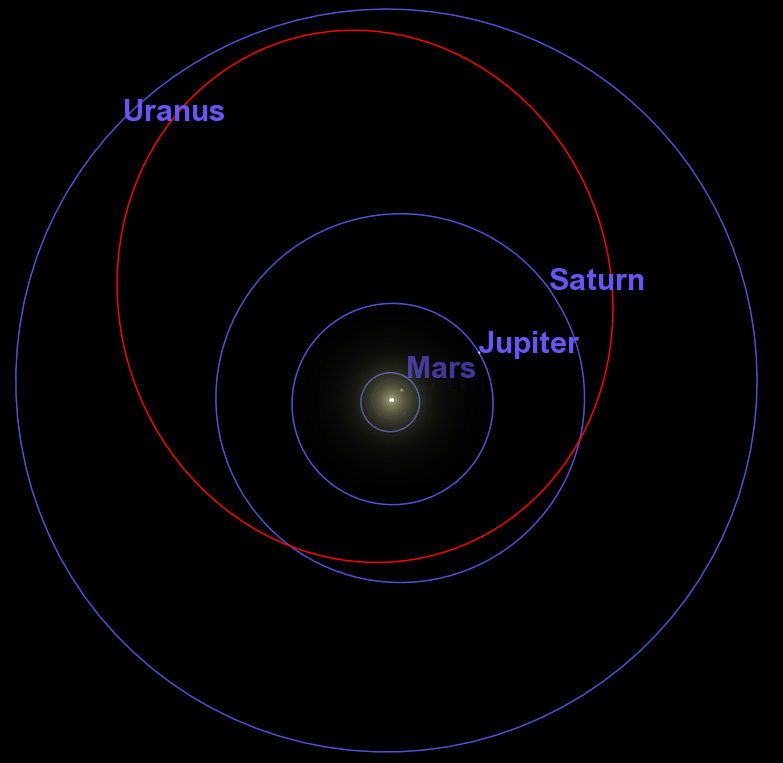
Early in 1988, Chiron brightened substantially. Asteroids don’t do that. But comets do as they approach the sun and develop a coma. Furthermore, additional observations revealed that Chiron had indeed developed a cometary coma, which accounted for its increase in brightness. So, is Chiron actually a comet? Modern textbooks usually classify it as both a comet and an asteroid. However, this is not entirely satisfactory. Unlike comets, Chiron never comes closer to the sun than just inside the orbit of Saturn. Moreover, it is much, much larger than any comet.
Chiron seems to belong to its own class, something in between an asteroid and a comet. A second member of this class was discovered in 1992 and named Pholus. Since then, hundreds have been discovered. We now refer to such objects as centaurs. The name is fitting since centaurs are the half-man half-horses of Greek mythology. By definition, a centaur orbits at an average distance in between the orbits of Jupiter and Neptune. Most of them cross the orbit of at least one of the giant planets. By convention, centaurs are named after famous centaurs of Greek mythology, including Chiron.[5]
Centaurs typically have characteristics intermediate between a comet and an asteroid. Many centaurs have dual or three-fold classification. For example, Chiron is classified as an asteroid, a comet, and a centaur. This may illustrate that our manmade classification systems are not always the best, and may need to be updated as our knowledge of the universe increases. No centaurs have been visited by spacecraft.
Notable Centaurs
We now have discovered several hundred centaurs. Several are particularly interesting. While Chiron was the first known centaur, it was not necessarily the first discovered centaur. By some criteria, that honor goes to Hidalgo which was discovered in 1920. But Hidalgo was thought to be a standard asteroid at the time of its discovery; its orbit crosses far inside Jupiter’s and so it is often found within the main asteroid belt. But its aphelion is near the orbit of Saturn. It was the most distant asteroid known in the early 20th century. There is some variation in the definition of a centaur, and some definitions would exclude Hidalgo.[6]
Chariklo was discovered in 1997. By some estimates, it is the largest centaur with a diameter of 144 miles. However, this is within the range of estimates of the size of Chiron; so further observations may change the ranking. Chariklo is interesting because it has rings! Two rings were discovered during a stellar occultation in 2013, the same way the rings of Uranus were discovered. The inner ring orbits at 246 miles away from Chariklo, and the fainter, outer ring is at 252 miles. Current technology does not allow us to view these rings directly. Chariklo is currently the smallest object with confirmed rings. However, there is some evidence that Chiron may also have rings.
Trans-Neptunian Objects
Minor planets that orbit beyond the average distance of Neptune are referred to as trans-Neptunian objects (TNOs). The first TNO was discovered in 1930 – that’s Pluto. But since no other TNOs were discovered for six decades, Pluto was classified as a planet. The second TNO was discovered in 1992 and given the name Albion. Two more TNOs were discovered in 1993, and four more in 1994. Several thousand TNOs are now known. These discoveries led astronomers to realize that Pluto is the largest member of a class of objects, and this resulted in its reclassification as a dwarf planet and TNO.
So, we now have terminology for all known small-solar system bodies based on their orbit. Any small non-comet that orbits the sun directly is (1) an asteroid or minor planet if it orbits at or closer than Jupiter, (2) a centaur if it orbits between Jupiter and Neptune, or (3) a trans-Neptunian object if it orbits beyond Neptune. There is some overlap since some centaurs are also classified as minor planets. Small solar system bodies that are large enough to be round by their own gravity are classified as dwarf planets, in addition to their other classification (TNO or asteroid).
Two broad classes of TNOs exist based on their orbital characteristics: KBOs and SDOs. TNOs that orbit closer to the sun than 55 AU, are often referred to as Kuiper belt objects (KBOs). The name is somewhat misleading since these are not the trillions of small, comet-sized objects that secularists predicted to find at this distance. Rather, they are much larger, and fewer. KBOs have relatively low orbital inclinations and are further divided into resonant objects, and classical objects (also called cubewanos). Resonant objects are in an orbital resonance with Neptune, whereas classical objects are not.
In the resonant object bin, there are many TNOs that orbit at the same average distance as Pluto, and consequently have the same orbital period. These are called “Plutinos.” Recall, Pluto is in a 2:3 resonance with Neptune, meaning it orbits twice as Neptune orbits three times – a very stable configuration. Hence, Plutinos are in a stable 2:3 orbital resonance with Neptune. Additionally, some TNOs orbit in an apparently stable 1:2 resonance with Neptune. These are called “twotinos.”
The more distant TNOS are referred to as scattered disk objects (SDOs). SDOs tend to have higher inclinations and orbital eccentricities. This is very perplexing for secular models of solar system formation since there is no way to naturally cause such orbits. But it is very consistent with the patterns the Lord has built into His solar system. We saw that with planets, most inner moons orbit in the same plane and with circular orbits as a design feature, whereas the outer moons had more eccentric, higher inclination orbits. The solar system itself apparently exhibits this same pattern.
The Largest TNOs
In general, TNOs tend to be significantly larger than asteroids, although there is a significant overlap in sizes. Consider that four of the five dwarf planets in our solar system are TNOs, with Ceres being the only asteroid member. A dwarf planet is a small solar system body that orbits the sun directly, but has sufficient gravity to be in hydrostatic equilibrium (round or ellipsoidal). The largest four TNOs, which are also dwarf planets, are Pluto, Eris, Haumea, and Makemake.
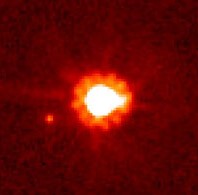
and Dysnomia (fainter
and to the left) as imaged
by the Hubble Space Telescope.
Eris was discovered in 2005 and was originally estimated to be slightly larger than Pluto. But more recent estimates place Eris as the second largest TNO with a diameter of 1445 miles. However, Eris is the most massive known TNO, outweighing Pluto by 27%. It is in the scattered disk category. Eris is orbited by a moon named Dysnomia[7] which has been directly observed using ground-based observatories and also from the Hubble Space Telescope. Eris is the largest and most massive solar system body that has not yet been visited by spacecraft. And considering its distance, this will likely remain the case for some time. Eris orbits the sun at an average distance of 6.3 billion miles, about 74% farther than Pluto’s average distance. At such a distance, Eris takes 559 years to orbit the sun. Consequently, we have no detailed images of its surface.
Haumea is currently estimated to be the third largest TNO, although its precise size has been difficult to estimate. From studying the light curves of Haumea, astronomers believe that it is a triaxial ellipsoid, more than twice as wide as it is tall, and with a rapid rotation of 3.9 hours.[8] Haumea has two moons: the inner moon Namaka, and the larger outer moon Hi’iaka. From their orbits, we know that Haumea is one third the mass of Pluto. In 2017, astronomers found evidence from a stellar occultation that Haumea has a ring. This is the first ring discovered around a TNO. The ring slightly increases the brightness of Haumea in ground-based telescopes, which contributes to the uncertainty in computing the size of this dwarf planet.
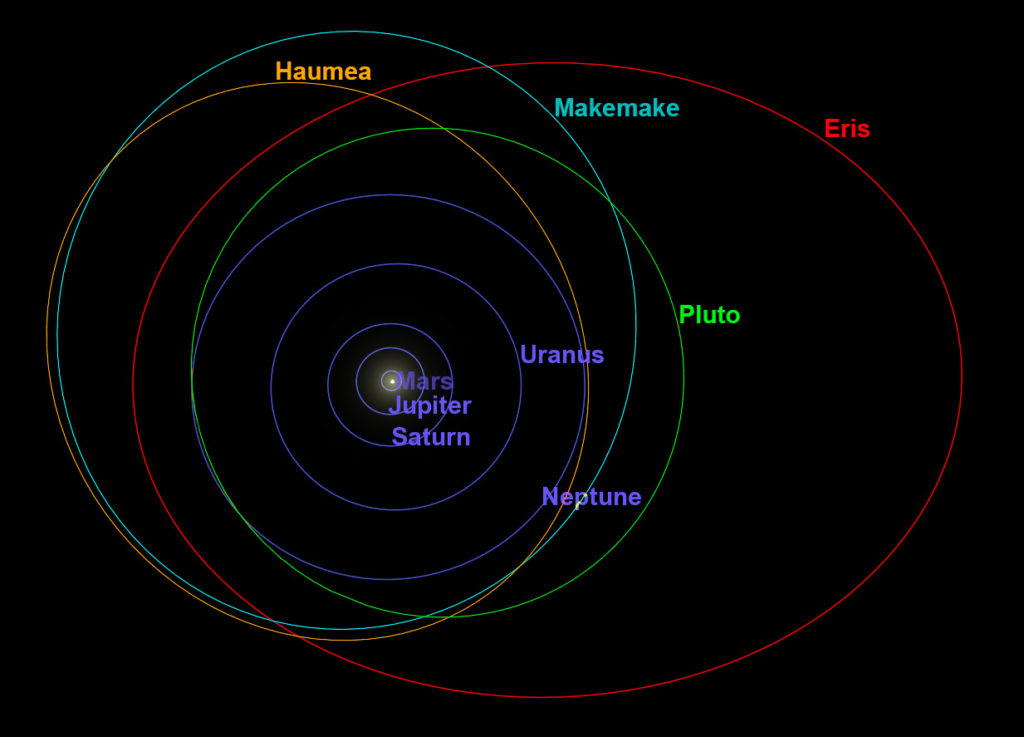
Makemake[9] is the fourth largest (known) TNO, and the smallest of the five dwarf planets currently known in our solar system. It is usually classified as belonging to the classical group (cubewano). However, it has an unusually high inclination (29 degrees) for that group. Makemake is 870 miles in diameter and is the second brightest TNO as seen from Earth (Pluto is the brightest). As such, it is potentially detectable in a moderately-sized backyard telescope under extremely dark skies. Makemake has one known moon with a diameter of 110 miles. Informally named MK2, the little moon has yet to receive an official name.
Other Notable TNOs
The aforementioned TNOs are large enough to be round (or ellipsoidal) under the force of their own gravity and are therefore also classified as dwarf planets. However, all other known TNOs are estimated to be too small to fit this criterion. Still, some are very interesting.
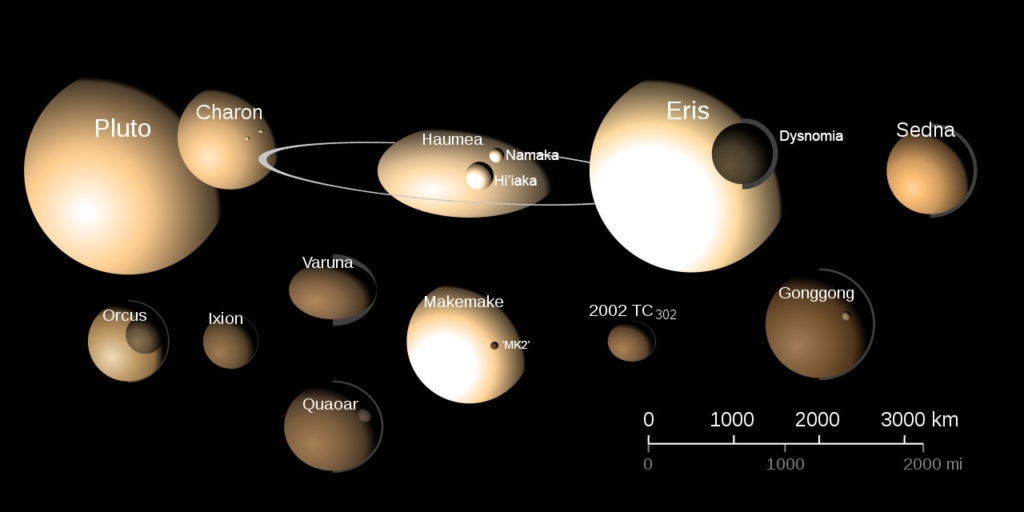
Modified from the original here, under GNU Free License.
Sedna is one of the most distant TNOs, currently at 85 AU from the sun (nearly three times the distance of Neptune). But Sedna’s elliptical orbit carries it out to a distance of 937 AU – about 31 times the distance to Neptune! At such a distance, Sedna has not yet completed even one orbit around the sun since creation. It is very red in color, and is classified as a scattered disk object (SDO).
Arrokoth is an unusually small TNO, only 22 miles long, and shaped rather like a snowman. Discovered in 2014 and given the provisional name Ultima Thule, this little cubewano is the only TNO besides Pluto to have been visited by spacecraft. The New Horizons spacecraft, which flew past Pluto in 2015, went on to explore Arrokoth in 2019. At a distance from the sun of over four billion miles, Arrokoth is currently the most distant object ever visited by spacecraft.
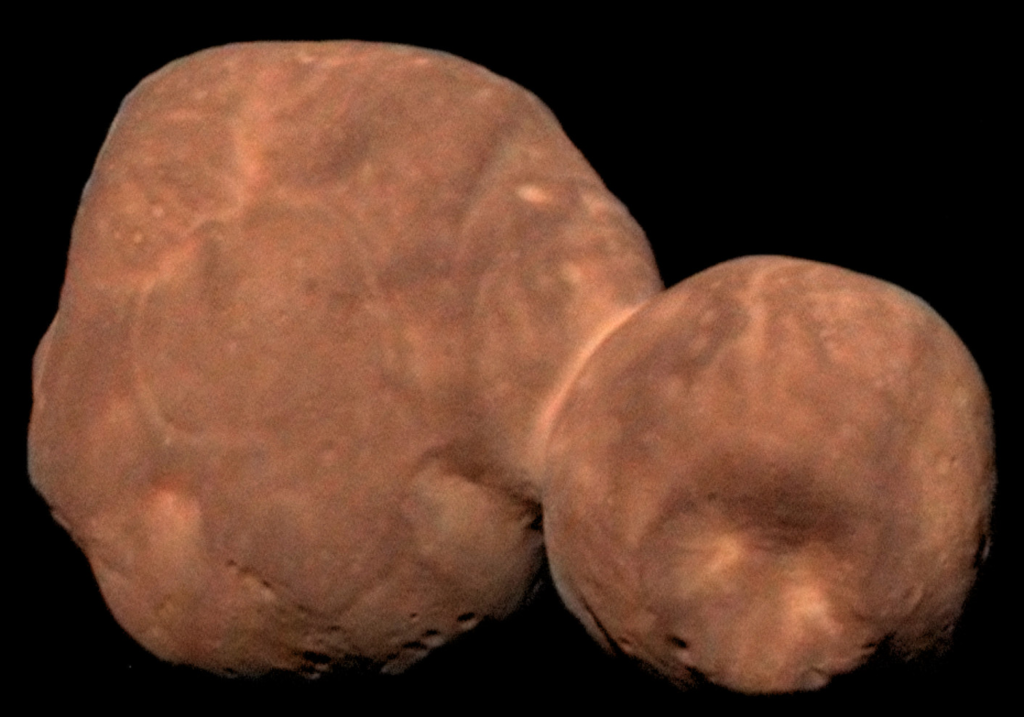
Arrokoth is a contact binary, meaning it has two components that revolve around each other while connected by a “collar.” The collar itself is unusually bright. The two lobes of Arrokoth are referred to as “Ultima” and “Thule” respectively. Ultima is the larger lobe, and is actually rather disk-shaped. Thule is smaller and approximately spherical. Both lobes are distinctly red in color.
Commencement
We here conclude our brief exploration of the solar system. We have examined the sun, the eight planets, their moons, dwarf planets, asteroids, centaurs, comets, and trans-Neptunian objects. Many of these worlds have been visited by spacecraft. But many have not. So, there is still much to discover in our solar system.
But consider that in all these articles, we have explored just one solar system. We now know that many other stars also have a system of planets. Currently, only a few of these planets have been directly imaged, and they appear as a tiny point of light. But that is just how the planets in our own solar system appeared before the invention of the telescope in 1608. As technology continues to advance, we may one day be able to view these extra-solar worlds in as rich high-resolution detail as we currently have for the worlds of our own solar system. And there are over 100 billion stars in our galaxy alone, and at least 100 billion galaxies in the visible universe. Clearly, there is much left to discover.
In the future, perhaps some student of science will be able to pick just one of these stars, and do an article series on its system of planets, moons, comets, asteroids, and perhaps objects yet to be discovered, and how all these glorify God. What other beautiful and interesting worlds has the Lord placed in His universe? The adventure is just beginning.
[1] The word “comet” comes from the Greek and means “hairy.”
[2] Hale-Bopp has an exceptionally large nucleus that is estimated to be between 19 and 25 miles in diameter. Hale-Bopp also broke the record for longevity. It is the only comet in recorded history to have remained visible to the naked eye for over a year and a half. That’s over twice as long as the previous record held by the Great Comet of 1811.
[3] Occasionally, a comet will possess a third “sodium” tail. However, this third tail is normally much fainter than the ion and dust tails, and is nearly impossible to detect in standard images.
[4] The orbit of Hale-Bopp was altered by gravitational perturbations of the planets during its trip through the inner solar system in 1997. Its previous orbital period was around 4200 years, and its new orbital period is around 2533 years.
[5] Chiron was one of the most famous centaurs in Greek mythology. He was depicted as wise, peaceful, and knowledgeable of medicine.
[6] By some definitions, a centaur must have a perihelion distance (rather than average distance) greater than Jupiter’s distance from the sun. This would exclude Hidalgo as a centaur. But since most centaurs do not cross Jupiter’s orbit, they would not be affected by the alternative definition.
[7] The moon Dysnomia enabled astronomers to measure the mass of Eris. The orbital period of a moon depends solely on its orbital distance and the mass of the body it orbits.
[8] This does not violate the condition for a dwarf planet that it must be in hydrostatic equilibrium. We normally think of this condition as spherical. But for a rapid rotator (like Jupiter), hydrostatic equilibrium results in an ellipsoid.
[9] The name Makemake is pronounced mah-kay-mah-kay.

